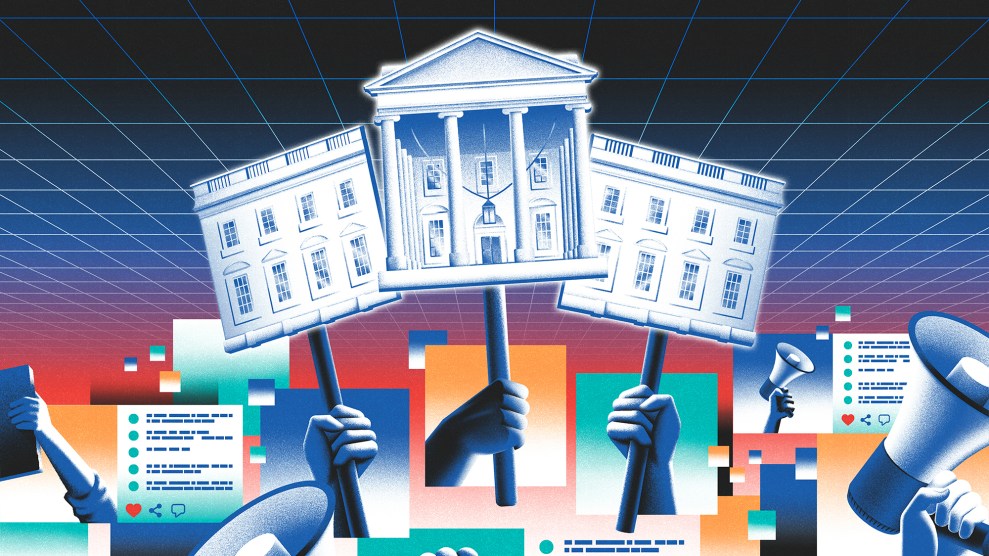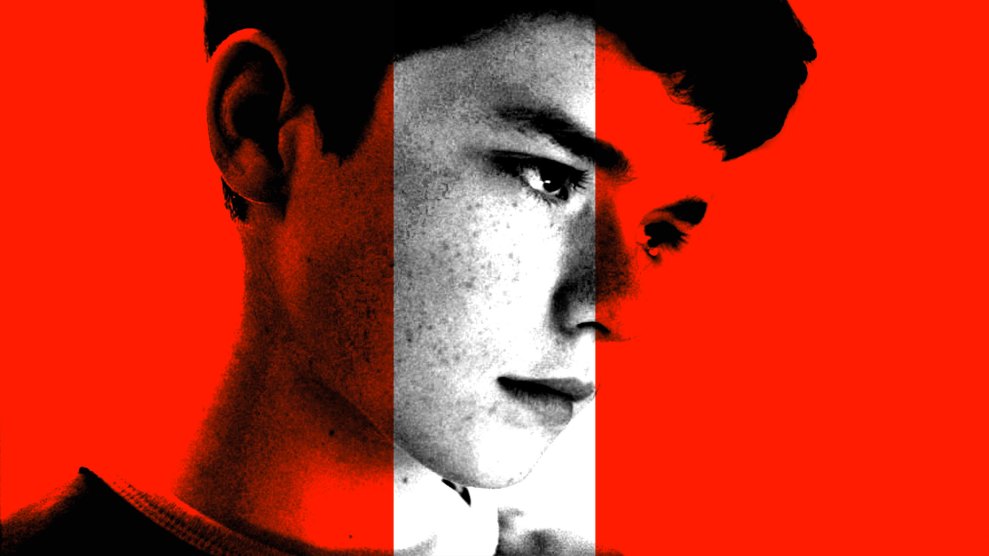
Mother Jones; Eddy Chen/HBO
Like most girls in her generation, Jules, a character on HBO’s groundbreaking teen drama Euphoria, falls in love through her phone. “Literally just had the most amazing night talking to Tyler,” Jules, a high school junior, texts her best friend and classmate, Rue, referring to the crush she’s been messaging for weeks. Jules texts Tyler nonstop: in class, before she falls asleep, and first thing in the morning when she awakes. As she gazes into her screen, she can’t stop smiling. “I’m legit falling for him,” she tells Rue.
But Jules’ romance on the show, which is airing the final episode of its first season on August 4, isn’t quite like other high school love stories on TV. Jules is transgender, and her character is played by the model and actress Hunter Schafer, who is also trans. And that’s just what got me hooked on her storyline: in part because show creator Sam Levinson allowed Schafer to help shape the character, Jules is the best portrayal of a trans girl that I have seen in media.
Jules meets Tyler, who goes by the username ShyGuy118, on a hookup app that looks just like Scruff, a real-life dating app for “gay, bi, trans, and queer guys to connect.” Though Jules is not any of those things, she has a history of using the app to meet men who are into sleeping with trans girls like herself.
But this exchange eventually turns sour, when Jules finds out “Tyler” is actually a fake name used by Nate, the conniving jock whose flirtation with Jules becomes part of a scheme to protect his family. After coaxing Jules into sending nudes, Nate threatens to get her charged with distributing child porn unless she stays silent about their virtual romance—and the fact that she previously slept with his dad. The show hints that Nate wrestles with his sexuality—he’s insanely awkward about seeing naked men in the locker room, while his phone is littered with other guys’ dick pics—but it’s unclear if he has feelings for Jules or merely uses her for his own selfish ends.
My own dating life isn’t quite so dramatic, but whether Jules is tempting a straight-identified man, or simply getting played, I can relate. I’ve chatted online with many boys like ShyGuy118, who are attracted to my femininity and intrigued—or explicitly turned on—by the fact that I have a dick. The vast majority of these trans-attracted men have come into my life through Grindr, and many trans girls I know say the same. The app gives men “a somewhat more secure way of cruising us,” says Charlene Incarnate, a prominent trans drag performer in Brooklyn. “All of my non-queer-identified sex partners [come] from Grindr.”
While originally launched as a gay dating app, Grindr now includes “trans and queer people” in its marketing language, and photos of trans femmes on its homepage. A Grindr spokesperson told me that trans people are “integral” to the platform, which in 2018 added profile fields allowing users to display their gender identities and pronouns. A spokesperson for Scruff, who was pleased by Euphoria’s nod to the app, says that roughly 5 percent of its users are either trans-identified or looking for trans people. Based on the composition of my local grid (the place in the app where nearby users’ pictures are displayed), I’d venture to say that Grindr’s rate is even higher, with a rising prevalence of trans femmes specifically. As a result, more and more straight men, like, supposedly, “Tyler,” are using gay apps to meet trans girls like Jules and myself.
For years, I used these apps while presenting as male. Choosing feminine photos would turn off many gay men. But when I started transitioning and began using photos in which I looked like a woman, my Grindr experience completely flipped. Before, most of the attention I got was from gay men who treated me with bullish impatience, demanding nudes in caveman English. My trans femme looks attracted more straight guys, who hewed to a different cultural script; they tried to charm me with pickup lines and offered to take me on dates. After a long day of getting misgendered in public, I found great validation in turning on my phone to finally be treated like a lady.
Of course, being treated like a woman often meant being treated like shit. After a few minutes of their superficial charms, the straight guys also wanted nudes. Many of them catfished me, using fake profiles as bait for my pics, or beguiled me with late-night chats that vanished in the morning, when I’d discover that the boy of my dreams had blocked me. “Whenever I log on, I get notified that several people in my inbox have deleted their profile, which I believe is only really common for [trans women],” says Charlene. The men who contact her are “still getting lost in their own hangups.”
My encounters with trans-attracted men tend to be mottled by a layer of shame. Like Nate, aka Tyler, they withhold their real names. They Snapchat me from burner accounts—not the ones they use to snap their friends—and their promises of dates are often achingly hollow. After texting me for weeks, they are too afraid to meet. They ghost without a word of explanation.
In an effort to better understand what’s going through these boys’ heads, I reached out to Perry Gruber, who counsels trans-attracted men through his program, the Transamorous Network. Gruber says the men he works with are often insecure and confused as to whether their attraction to trans women is “wholesome and legitimate.” If they “subscribe to the flawed premise” that everyone with a penis is male, they might wonder if their attraction to trans women makes them gay, or view it as “a perversion to be exorcised.” These men are stigmatized not only by society, says Gruber, but also by the trans women they seek. Many of us are quick to write them off as “chasers,” a term that implies they are exploitative harassers who fetishize trans bodies.
The Transamorous Network aims to help men rise above “chaser” behaviors to become “transamorous,” a word Gruber defines as suiting someone who is “out and proud about their trans attraction” and treats their lover “as a whole human being,” having overcome shame and insecurity. TJ Billard, the University of Southern California researcher behind one of very few studies on trans-attracted men, observed a “significant” amount of shame in those he surveyed. “It’s an external shame specifically,” he tells me. “Shame about not wanting people in their lives to know that they have these desires.”
Gruber, who also runs a spiritual support network and identifies as transamorous himself, agrees with me when I point out that the number of trans-attracted men who treat their romantic partners as whole human beings seems small. Then I ask him whether Euphoria or other positive depictions of trans people have started coming up in his work.
“No, not particularly,” he says. “Most of the guys we’ve talked with get their ongoing awareness of trans women from porn.” This doesn’t surprise me. It’s consistent with the work of trans journalist Diana Tourjée, whose stories about trans-attracted men reveal that many cite porn as an influence. “I first realized I was interested in trans women when I watched trans porn as a teenager,” says Jeremy, a 20-year old she recently interviewed. The popularity of trans porn has been rising for years, which might suggest more embrace of trans attraction. Billard’s study found a small but significant association between trans porn viewership and positive attitudes toward trans people. Yet on porn sites, the “Trans” genre is often listed under “Fetish,” alongside “Bondage” and “Toys.” As long as people’s interactions with trans folk are confined to a sexualized and often violent medium, their relations with us are shaped accordingly.
Euphoria depicts the ways porn is warping teens’ expectations of sex. When Jules’ classmate Cassie objects to her older boyfriend McKay’s attempt to choke her during coitus, he replies, seemingly in earnest, “I thought you liked that,” after a montage of popular Pornhub videos show women being degraded. Trans women in porn are treated much like their cisgender counterparts: as objects made for male pleasure. It makes sense that boys on apps are content to interact with me virtually: The context is familiar to them, and if they don’t meet me in the flesh, there’s less impetus to treat me like a person than a thing that will fulfill their fantasy and then disappear when convenient.
“I have a theory about fetishes,” says writer Juno Dawson in a gorgeous essay about dating while trans. “If society has no issue with your tastes (tall men, big boobs, leggy, beards, tattoos), it is a ‘type.’ However, if you are into something society frowns upon (plus-size people, trans people, leather, rubber, watersports), it is a ‘fetish.'” She writes that many of the men who reach out to her on apps are longing to satisfy their own curiosity, with little regard for her needs. Through porn, boys “are learning that sex is, primarily, an activity in which they will gain pleasure and dominance.”
Before having her virtual romance with Nate, Jules first meets his dad through the same gay app. He messages her from the handle “Dominant Daddy.” In the motel where they meet, he penetrates her suddenly and roughly; the scene is difficult to watch. Later, we watch him break down in a parking lot when he asks Jules not to go public about the incident, most likely because she’s underage, but presumably also because it’s not socially acceptable for him to lust after trans girls. By this point, we’ve learned that Nate was a kid when he started secretly watching his father’s homemade porn, all of which depicts his “Dominant Daddy” topping trans women, gay boys, and femmes.
A deep sense of shame fuels Nate in his convoluted scheme to silence Jules. The idea that his straight, married dad has these kinds of interactions is so dangerous that he’s willing to ruin a young girl’s life to keep the secret from getting out. I suspect Nate is also contending with his own attraction to Jules. “Over the past few weeks I’ve spent every moment of every day getting to know you,” he tells Jules when they finally meet face-to-face. “I kind of feel closer to you than I do to anyone in the whole world.” Since many other scenes depict Nate lying through his teeth, we don’t have much reason to trust him. But based on my exchanges with boys like Nate—who were high school quarterbacks, have girlfriends, and identify as straight—I think there’s a kernel of truth in what he says to Jules in private.
A certain special intimacy can exist between trans women and cis men. Perhaps because approaching us means violating a taboo, they become open to revealing other hidden facets of themselves, at least via text. “Ugh ur so sweet,” Jules messages Nate. “Only to u,” he replies. “No one irl would ever call me sweet.” The boys who hit me up on Grindr express a desperate, buried longing to be held. They often want to be topped or even dominated. They seek in trans women everything they’re not supposed to desire. When they ultimately ghost, it is for fear of not only the stigma around trans attraction, but also of their own vulnerability.
What Nate does to Jules is just one small example of the violence being done to trans women every day, often by men who are attracted to us. There are worse fates than being catfished: So far in 2019, at least 12 trans women have been killed (all of whom were black). Many trans people are murdered by intimate partners, who are perhaps overcome by an upswell of shame. Harper Jean Tobin, policy director for the National Center for Transgender Equality, has suggested that the violence may be motivated by the fear of being associated with trans people—by “the stigma related to trans people and the perception that it’s somehow more acceptable to abuse transgender people because they are less than other people in society.”
Mitigating such violence has to involve not only lifting up the value of trans lives, but also creating space for straight-identified men to have a wider range of desires. There is a certain onus on all of us to let them have that space, but in the end, they’ll need to stake it out for themselves. Men like Nate and his father are afforded privileges that allow them to bend the social order to their will. Their support could make the world safer for trans people, if only they had the courage to meet us as complete beings, as more than a fantasy or images on a screen.













